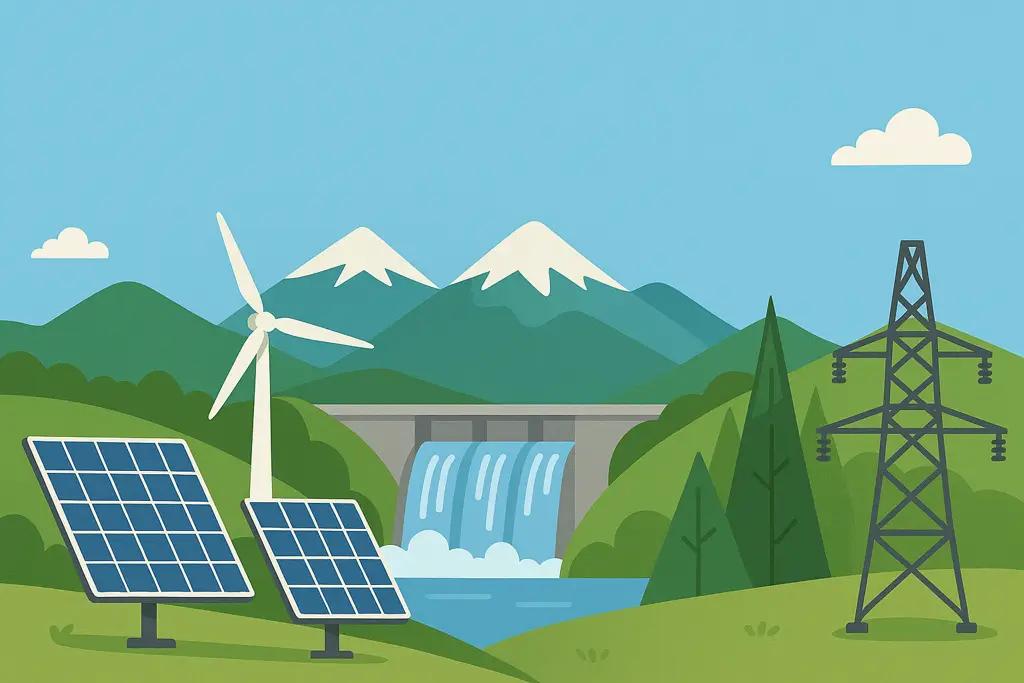
Published
05/13/2025, 18:08Kyrgyzstan has historically focused on hydropower, taking advantage of its abundance of mountain rivers. But water is not an endless resource. Moreover, in the context of climate change and growing agricultural needs in Central Asia, the issue of rational and careful water consumption is particularly acute.
According to the FAO, Kyrgyzstan is one of the three countries in Eastern Europe and Central Asia most vulnerable to climate change. Water volumes in the region are rapidly declining due to reduced precipitation and glacier melt.
At the same time, the country's economy is largely dependent on water resources. About 90% of all water in Kyrgyzstan is used for agriculture, especially for irrigation. Up to 94% of all electricity is generated from rivers and reservoirs. Therefore, any climate change will inevitably affect everyday life, not only in Kyrgyzstan but also in neighboring countries.
The republic needs to introduce modern water-saving technologies in agriculture and at the same time diversify its energy sources — fortunately, the country has the potential to develop renewable energy sources.
Energy Minister Taalaibek Ibraev has announced plans to increase the capacity of small hydropower plants to 405 megawatts by 2027, which will help reduce the electricity deficit. Kyrgyzstan's hydropower potential includes 268 rivers, 97 large canals, and 18 reservoirs with a total generation capacity of 143 terawatt-hours per year. Currently, about 10% of this potential is being utilized.
The development of small hydropower plants is one of the government's priorities, as it reduces emissions and dependence on fuel imports. It is estimated that the energy potential of small rivers allows for the construction of about 87 new hydropower plants with a total capacity of about 180 megawatts.
However, as the minister noted, this is only part of a broader strategy—by 2030, Kyrgyzstan plans to become an exporter of electricity.
"Yes, hydropower is an important part of the energy system and is formally classified as a renewable source. But it comes with risks: climate fluctuations, seasonal water shortages in winter, and the transboundary nature of rivers (Syr Darya, Naryn) make it vulnerable. Therefore, the development of solar and wind energy is not an alternative, but a necessary addition. This reduces the burden on water resources, provides energy to remote regions, opens up export potential (for example, through CASA-1000) and reduces the environmental and social risks associated with dam construction," explains Oksana Gudkova, a renewable energy engineer at UNISON Group. Oksana Gudkova.
Dependence on hydropower increases economic vulnerability: most of the electricity is produced by large hydropower plants that depend on water availability. According to the UN, accelerated glacier melt threatens the region's water security. New hydroelectric facilities could lead to the loss of agricultural land, resettlement, and other social consequences. The transboundary nature of water resources further complicates the situation: as the “water rent” (9% of global reserves) decreases, the risk of conflict increases.
“The forced development of river hydropower without considering the environmental consequences and compensatory measures could lead to the degradation of natural complexes, the loss of biodiversity, and the undermining of the region's environmental sustainability,” writes Alexander Eskendirov, an environmental journalist with the Rivers.Help! project.
Kyrgyzstan has the potential to safely increase its energy capacity. The government sees diversification of energy sources as the key to sustainable development. At the same time, interest in solar energy is growing worldwide. According to forecasts, by 2030, the share of green electricity will grow to 46%, mainly from solar and wind power.
According to McKinsey, by the middle of the century, solar and wind power stations could account for about 70% of global capacity. This is due to cheaper tech: solar panels got 85% cheaper between 2010 and 2020. Using solar energy in Kyrgyzstan helps with both domestic and global decarbonization goals.
The solar energy potential in Kyrgyzstan is estimated at 267,000 megawatts, with the country receiving more than 4.6 billion megawatt-hours of solar radiation annually — an average of 23.4 kilowatt-hours per square meter.
Wind energy is still underdeveloped, but research has identified significant areas suitable for industrial wind turbines. The annual wind potential could reach 44.6 million kilowatt-hours. Investors are already showing interest in solar energy.
In 2022, an agreement was signed with Chinese companies to build a 1,000-megawatt solar power plant in the Issyk-Kul region. In 2024, the Eurasian Development Bank and Bishkek Solar agreed to finance a 300-megawatt solar power plant in the same region. These projects will provide the country with about 1.3 gigawatts of new capacity.
According to some reports, the government has approved solar power plant projects with a total capacity of 2–2.5 thousand megawatts. According to the UN roadmap, by 2030, Kyrgyzstan will need about 4,000 megawatts of solar power, which is several times more than the current level, meaning that the potential is far from exhausted.
The development of solar energy in Kyrgyzstan is in line with global trends and reduces energy vulnerability. Unlike dams, solar power plants are modular and can be built in a few months. They do not depend on water resources and operate year-round, especially in summer during the dry season. The transition to solar power plants will reduce dependence on imports of electricity, coal, and gas, and increase the flexibility of the energy system.
The government is strengthening the regulatory framework to support renewable energy sources. In 2022, a new law on renewable energy sources was adopted, expanding the concept of RES, introducing flexible financing mechanisms and state guarantees for investors.
Another important measure was the guaranteed purchase of electricity at fixed tariffs for a period of at least 10 years. This allows investors to plan with confidence and minimize market risks. Green energy producers are also guaranteed priority access to the grid and exemption from licensing for small facilities.
The state is simplifying access to land: plots can be provided on preferential terms or free of charge. And the Green Energy Fund offers grants, loans, and advice, reducing financial barriers.
The European Union and other global players see energy cooperation with Central Asia as a promising area.
As part of Global Gateway, the EU has announced large-scale investments in sustainable infrastructure in the region.
The EU's experience is of interest: its regulatory framework, technological innovations, and stable support create an effective model. It is important for Kyrgyzstan to adapt these approaches to local conditions.
In addition, the EU is a technological leader. Partnerships with European companies will provide access to cutting-edge solutions and help avoid costly mistakes. The EU also provides green loans, grants, and training for specialists.
Since the beginning of its work in Kyrgyzstan, Europe has invested around €100 million in the development of green technologies. In the last two years alone, the European Bank for Reconstruction and Development has financed projects worth more than €50 million. The EU has allocated an additional €11 million for sustainable infrastructure, including water supply and renewable energy sources.
Today, Kyrgyzstan is on the verge of an energy transition. And while hydropower remains the backbone of the energy system, it is not without reason: it is efficient and relatively environmentally friendly.
"The efficiency of hydroelectric power plants reaches 90%, while solar power plants achieve 15–22%, wind power plants 30–45%, and biomass power plants 20–40%. In addition, hydroelectric units provide stable generation, unlike solar and wind power, which depend on weather conditions," explains expert Oksana Gudkova.
However, relying solely on hydropower is strategically risky. Kyrgyzstan needs to develop renewable energy sources not as a replacement for hydropower plants, but as a complement to them. This will ensure sustainability, climate adaptation, and regional stability.
A combined approach—modernizing hydropower plants and developing solar power plants on a large scale—will enable the country to achieve energy independence and sustainability, lay the foundation for economic growth, and make the energy system of the 21st century cleaner and more reliable.


